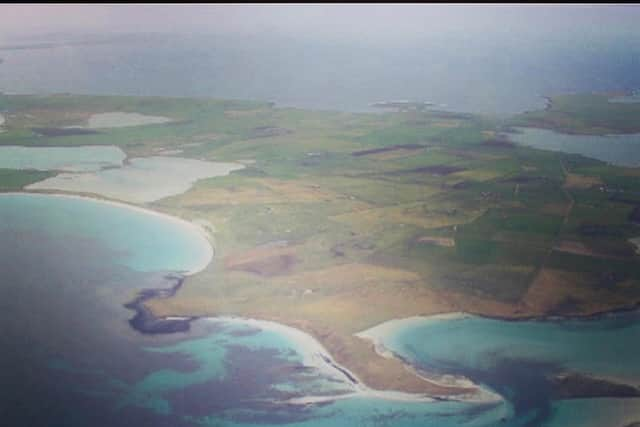Pictish stone of 'national significance' saved from new life as garden bench on Orkney
Malcolm Sinclair found the stone buried under roughly three metres of sand while working his land on Sanday, one of the outer-lying Orkney Isles.
The stone, which is roughly 10ft long, was buried under blown sand that had accumulated on a hillside overlooking a bay.
Advertisement
Hide AdAdvertisement
Hide AdMr Sinclair and his wife Jackie were unaware of the stone’s significance at first and had planned to move it to their garden to use as a bench.


But after Mrs Sinclair spotted the faint outline of a cross carved into the surface of the slab, county archaeologist Julie Gibson was called in to examine the find, with is now considered to be a ninth-century Pictish-era stone of national significance.
Mrs Sinclair said: “My husband was excavating sand in a pretty wild area of dunes and machair when he found this big rock and dug it out with his digger.
"He threw it aside and said we could stick it in the garden and use it as a bench.
"We went back a couple of weeks later and the rain had washed the surface a little. I took some photos and sent them to my friend, who is an archaeologist.
"I asked her if it was something or nothing. She said it could be something. I took some more photos and then was told not to touch it. Then everyone got very excited.”
Mrs Sinclair said she had spent a “few weeks of fascination” talking to archaeologists about the possibilities surrounding the stone and what it meant to the history of Sanday, which has a population of around 550, and those who lived there.
“We spent a lot of time standing on the hillside, overlooking the bay, wondering what life would have been like on Sanday and for the people who lived there,” Mrs Sinclair said.
Advertisement
Hide AdAdvertisement
Hide AdThe location of the stone is relatively close to another Pictish-era monument at Pool, on the south-western side of Sanday, an area that was occupied during several periods of time, from the Neolithic to the Victorian.
Ms Gibson said carvings on the newly-discovered stone were “very faint” and only became visible in the “right angle of light”.
She said: "The stone was found high on a hillside where this massive sand blow had altered the landscape. One thing we can already tell from this stone is that since around 1000AD, three metres of sand has built up on the landscape. It’s a sort of Pompeii effect.”
Ms Gibson added: “The stone is nationally significant and it contributes to our understanding of Christian Orkney and that feeds into the Viking story. That coming of Christianity was a hugely significant event.”
Further examination of the stone, which weighs around two tonnes, is due to take place.
Ms Gibson said: “There are all sorts of questions surrounding this stone. Was it originally made as a Pictish monument or was it a much older stone that was then adapted? Was it part of a settlement or a burial ground?
"There are hundreds of questions, and this stone might contribute an answer to some of them.”
A message from the Editor:
Thank you for reading this article. We're more reliant on your support than ever as the shift in consumer habits brought about by Coronavirus impacts our advertisers.
If you haven't already, please consider supporting our trusted, fact-checked journalism by taking out a digital subscription.
Comments
Want to join the conversation? Please or to comment on this article.
